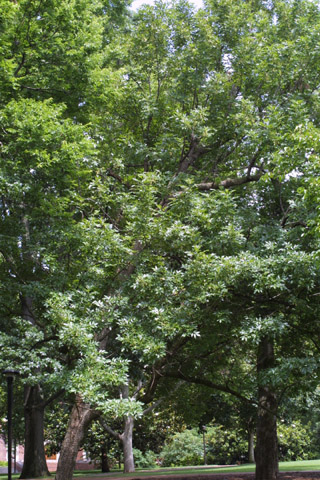
Permanent unique identifier for this particular organism:
http://bioimages.vanderbilt.edu/vanderbilt/5-64
Notes:
You can find this tree beyond the north end of Alumni lawn. It is easily recognized by the way it leans precariously to one side.
Ashes can be recognized by their pinnately compound, opposite leaves. Green ash is a dioecious species, and this particular tree is a female. In the fall it provides an opportunity to observe the paddle-shaped fruits. Distinguishing between green ash and white ash (Fraxinus americana) can be difficult but the wings on the green ash fruits tend to extend along the edge of the fruit towards its base, while the wings of the white ash fruits tend to stop at the thick part of the fruit. Large trees of both white and green ash tend to have bark that is broken up into square-ish plates. Another ash species that is common in middle Tennessee (but not represented in the arboretum) is blue ash (Fraxinus quadrangulata). It is easily distinguished from white and green ash by its square twigs which are quite different from the round green ash twigs and white ash twigs.
This grizzled veteran is by no means the most healthy green ash tree on campus, but it's included in this tour primarily because it is described on p. 68 of The Trees of Vanderbilt. That is its only claim to fame! Enjoy it while you can, given that it is not likely to survive the impending invasion of the emerald ash borer.
Ashes can be recognized by their pinnately compound, opposite leaves. Green ash is a dioecious species, and this particular tree is a female. In the fall it provides an opportunity to observe the paddle-shaped fruits. Distinguishing between green ash and white ash (Fraxinus americana) can be difficult but the wings on the green ash fruits tend to extend along the edge of the fruit towards its base, while the wings of the white ash fruits tend to stop at the thick part of the fruit. Large trees of both white and green ash tend to have bark that is broken up into square-ish plates. Another ash species that is common in middle Tennessee (but not represented in the arboretum) is blue ash (Fraxinus quadrangulata). It is easily distinguished from white and green ash by its square twigs which are quite different from the round green ash twigs and white ash twigs.
This grizzled veteran is by no means the most healthy green ash tree on campus, but it's included in this tour primarily because it is described on p. 68 of The Trees of Vanderbilt. That is its only claim to fame! Enjoy it while you can, given that it is not likely to survive the impending invasion of the emerald ash borer.
 |  |
Load database and switch to thumbnail view
Use this stable URL to link to this page:
http://bioimages.vanderbilt.edu/vanderbilt/5-64.htm
This organism is a living specimen that is part of the Vanderbilt University Arboretum with the local identifier 3-87.
This particular organism is believed to have managedmeans of establishment.
This organismal entity has the scope: multicellular organism.
Remarks:Mentioned in 1994 Trees of Vanderbilt book p.68. Died sometime before 2024.
Identifications:
Fraxinus pennsylvanica
Marshall
sec. Gleason Cronquist 1991
common name: green ash
family: Oleaceae
Identified 2002-06-27 by Steven J. Baskauf
Location:
Vanderbilt University, Nashville, Davidson County, Tennessee, US
Click on these geocoordinates to load a map showing the location: 36.14797°, -86.80427°
Coordinate uncertainty about: 10 m.
Location of individual determined from GIS database.
Occurrences were recorded for this particular organism on the following dates:
2002-06-27
2003-04-02
2014-09-11
The following images document this particular organism.
Click on a thumbnail to view the image and its metadata.Load database and enable navigation by taxon and organism.














